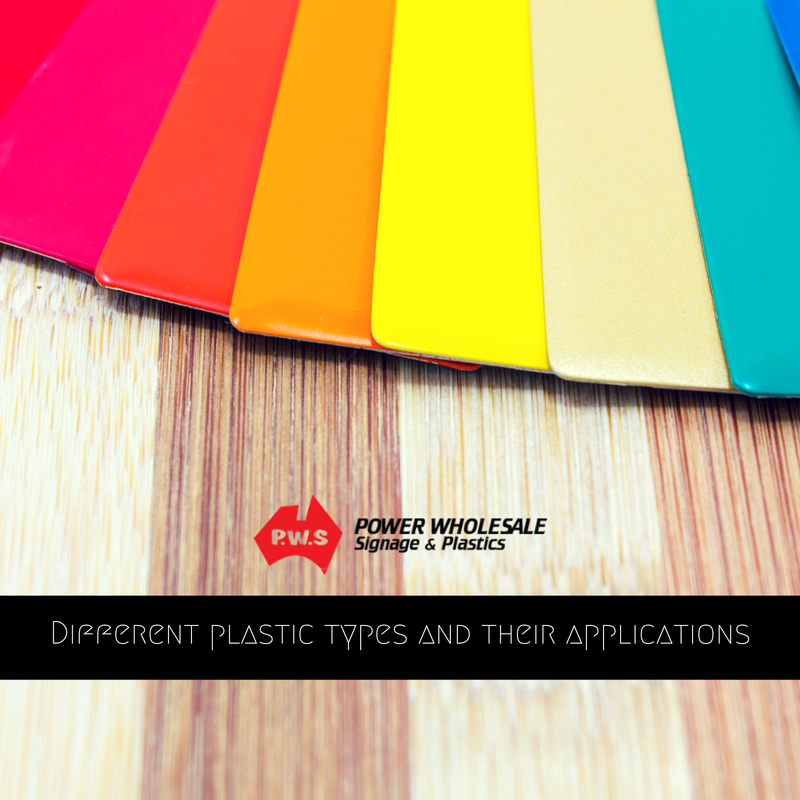When plastic is no longer just plastic

– different plastic types and their applications
Outdoor signs have come a long way since the ancient Roman times when they were made of stone. Today, plastic in its various forms has taken over as the most desirable material for outdoor advertisements due to its versatility, durability and cost effectiveness. But, as we all know, plastic has many different applications especially in the building industry, where it has truly found its niche.
Let us take a look at some of the plastic products that are predominantly used in these two industries to gain a better understanding why plastic has become almost indispensable in the modern day industrial world.
Acrylic Sheets
Acrylic, which also goes by trade names such as Acrylite, Plexiglas, Palglas, and Lucite is a transparent polymer often used in sheet form in the building industry. Acrylic is great as an alternative for glass as it is shatter-resistant. It actually offers ten to twenty times the amount of resistance that glass does, so it’s an effective way of protecting your windows against stray footballs or bricks.
Acrylic is perfect for windows, cutting boards and glazing or anywhere a transparent material is required. It has the advantage of better optical clarity compared to glass, and it insulates better. If you are the type who likes your quiet time, though, glass does a better job keeping out noise as it has a higher density.
The one drawback with acrylic though is that it scratches & clouds up if rubbed repetitively; you must therefore be careful to avoid scourers when cleaning surfaces made from this type of plastic.
Polycarbonate
Polycarbonates are used a lot in the building industry because they are tough materials which are virtually unbreakable. At the same time, they are highly pliable, making them easy to work with when molded and shaped using heat (known as thermoforming). Some grades of polycarbonates are optically transparent making them suitable for use in overhead glazing, skylights, signage and even boat windscreens.
Polycarbonate, which comes in a variety of brand names such as Lexan, Tafrolon, Makrolon among others, is preferred to other materials such as polyethene membranes and toughened glass because it is lightweight, but still capable of offering resistance against high impact objects. Over and above this, it still provides protection against UV rays and looks quite appealing to the eye.
PVC foam
Closed-celled PVC foam is a lightweight but robust material that is predominantly used for manufacturing outdoor and indoor signs and displays. Its unique mixture of polyvinyl chloride (PVC) and polyurea gives it water resistant properties that make it ideal for use in outdoor signage. In fact, PVC was originally used to make equipment for the military in the 1970s, finding its niche in the marine industry due to its ability to keep out water.
Foam PVC is a highly durable and versatile product used in a wide variety of signage solutions. Its immunity from elements such as rain and sunshine make it a wonderful selection for this application.
Another plus is its resistance to many solvents while working well with most adhesives and laminating resins.
High Density Polyethyl
High Density Polyethyl (HDPE) is a petroleum-based thermoplastic whose production started in the 1930s but really came into its own in the 1950s. HDPE is not only popular for its recyclability, but also for its wide range of applications ranging from plastic packaging and corrosion-resistant pipes, to commercial cutting boards – which is what we use it for here.
What makes this product your go-to plastic are its high strength-to-density ratio, water and chemical resistance and ability to withstand abrasion online cymbalta. HDPE has a resin identification code number 2, which makes identification and separation easier during recycling.
HDPE has actually spawned a whole different industry for recycled materials which churns out products such as storage containers, furniture, plastic lumber and automobile parts – to name a few. It’s no wonder that by 2007, the HDPE market internationally had reached more than 30 million tons.
Alupanel- Aluminium composite panel (ACP)
This is a sandwich panel made up of three layers – two thin aluminium sheets fused to a non-aluminium material (usually polythene) – at the core. This design enables the material to attain exceptional mechanical performance at minimal weight. These qualities make it ideal for use in internal and external signage products.
ACPs are also often used for external cladding, or frontages of buildings, and any type of internal cladding including partitions and false ceilings. Industries as diverse as packaging, and automotive and aircraft manufacture have also greatly benefited from the use of ACP.
Aluminium is versatile in that it can be painted using any type of colour metallic and non-metallic – as well as natural looking patterns like wood and marble.
Coreflute
Corflute is a lightweight, but tough, material made up of durable polypropylene which is usually stablilised against UV damage. It can therefore endure sunlight and varying weather conditions, as well as the effects of most oils and solvents – making it an ideal material for outdoor signage. Polypropylene is a recyclable material, making the copolymer a favorable product for the environmentally conscious.
Coreflute comes in a wide range of colors and thickness and is widely used in the signage industry especially for construction sites, real estate sales signs, and other outdoor advertisements.
